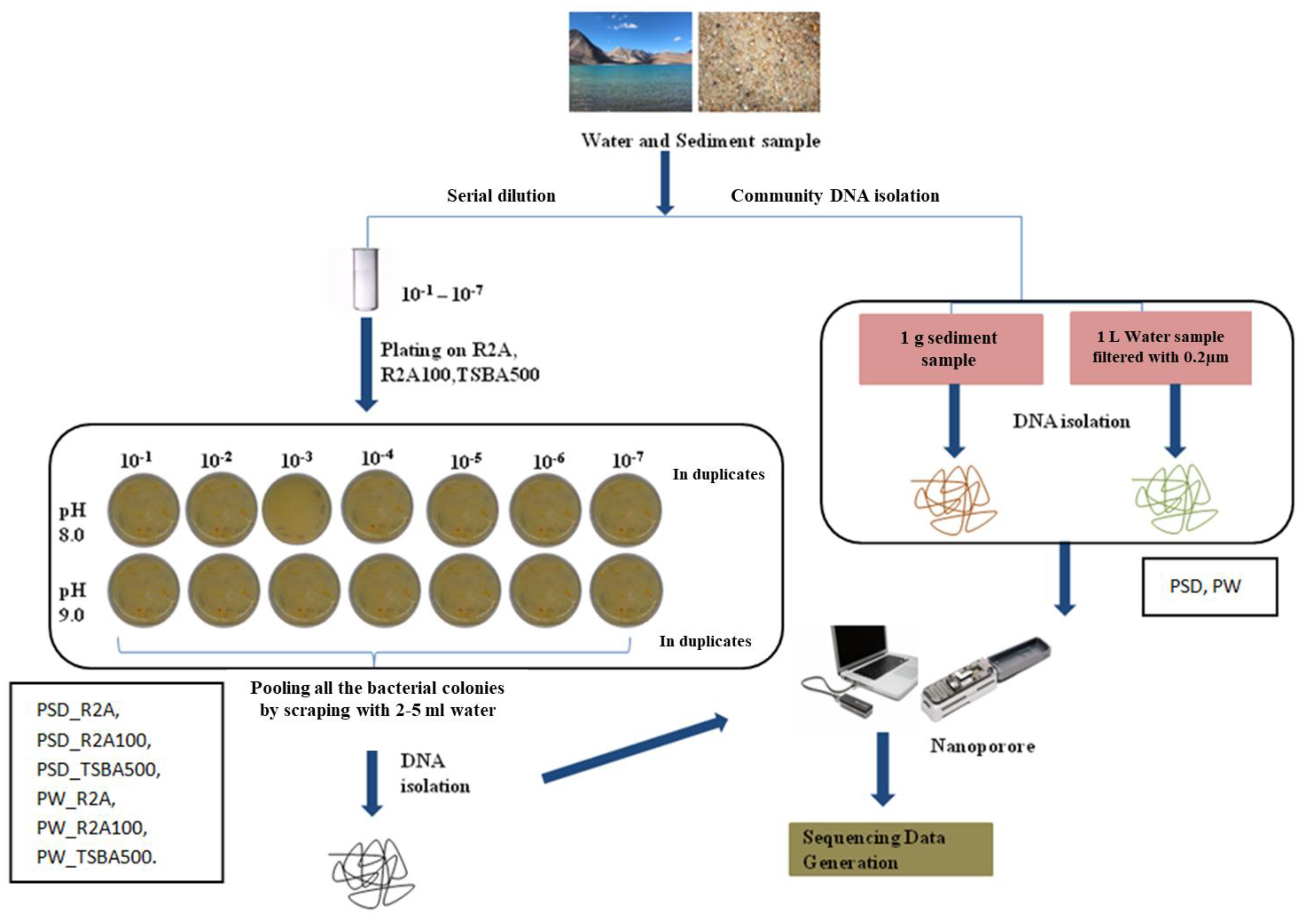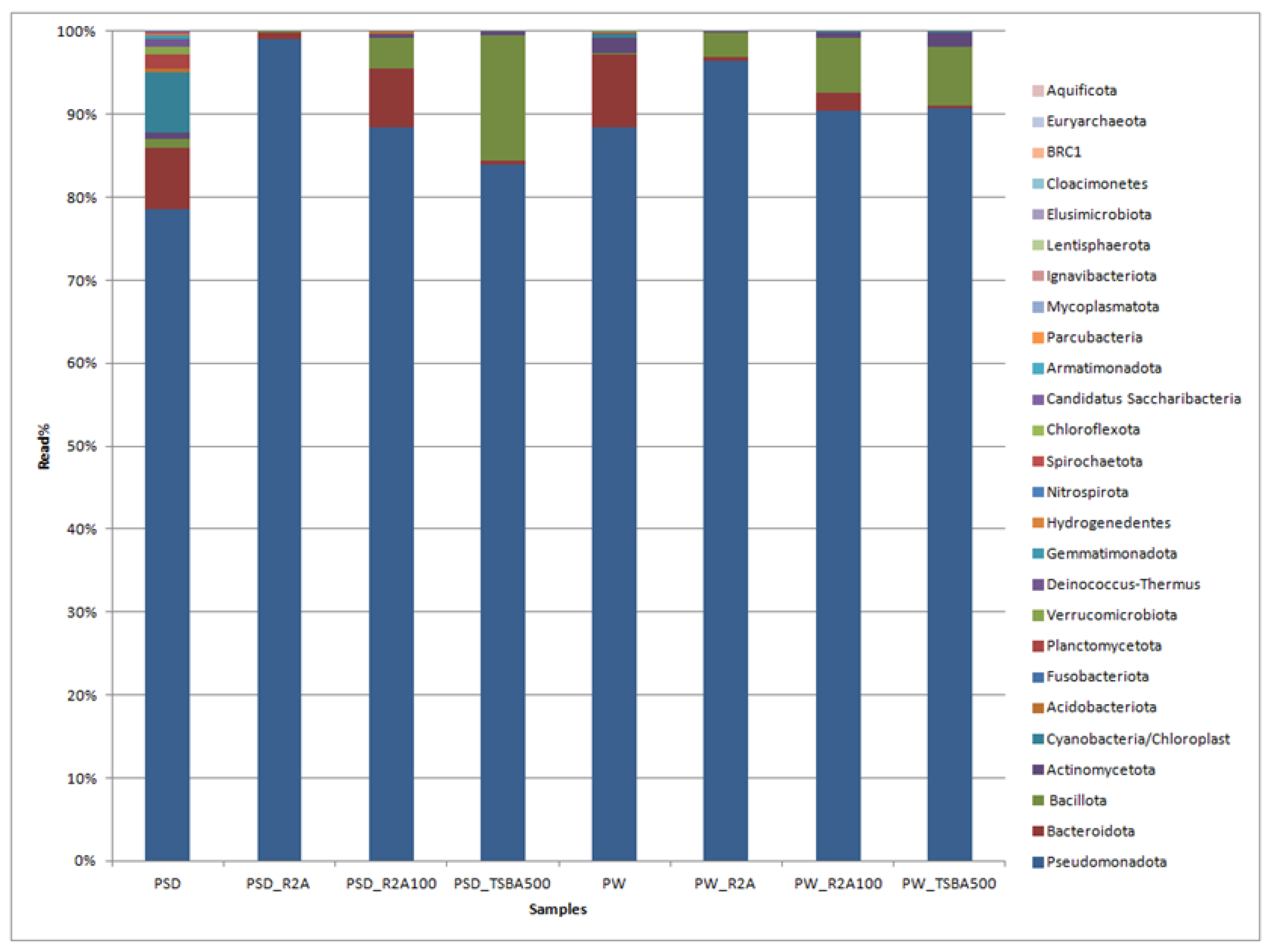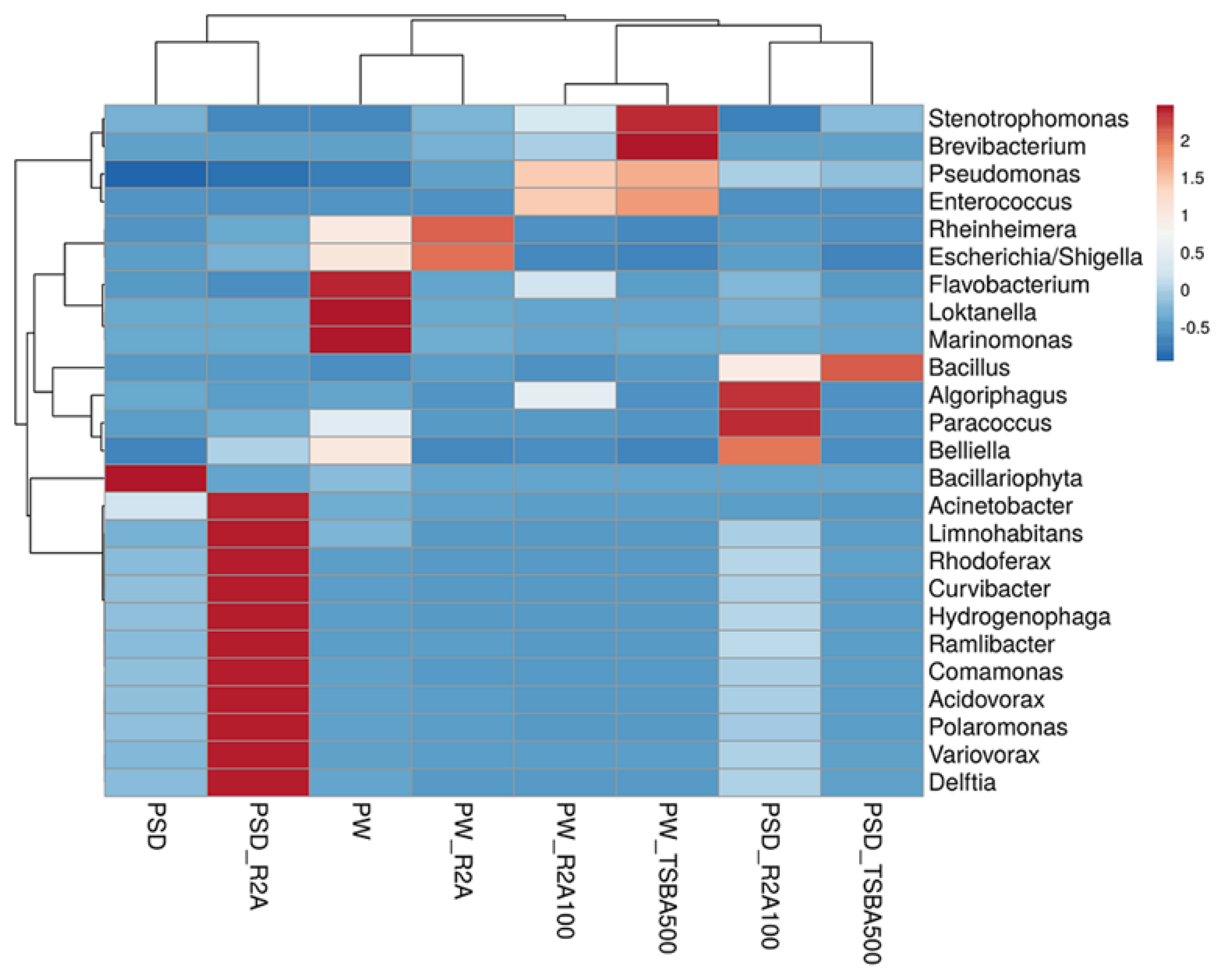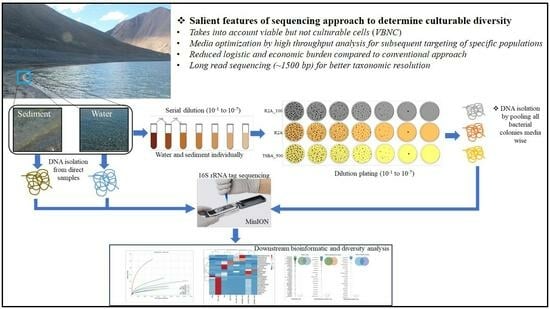Analysis of Culturable Bacterial Diversity of Pangong Tso Lake via a 16S rRNA Tag Sequencing Approach
Abstract
1. Introduction
2. Materials and Methods
2.1. Sample Collection
2.2. Physico-Chemical Parameters
2.3. Sample Processing and Community DNA Isolation
2.4. Sequencing and Data Analysis
3. Results and Discussion
3.1. Enumeration of Bacteria on Microbiological Media
3.2. Physico-Chemical Analysis
3.3. Analysis of Bacterial Diversity by 16S rRNA Gene-Based Tag Sequencing
4. Conclusions
Supplementary Materials
Author Contributions
Funding
Data Availability Statement
Acknowledgments
Conflicts of Interest
References
- Dong, H.; Jiang, H.; Yu, B.; Liu, X.; Zhang, C.; Chan, M.A. Impacts of Environmental Change and Human Activity on Microbial Ecosystems on the Tibetan Plateau, NW China. Gsa Today 2010, 20, 4–10. [Google Scholar] [CrossRef][Green Version]
- Hayden, C.J.; Beman, J.M. Microbial Diversity and Community Structure along a Lake Elevation Gradient in Y Osemite N Ational P Ark, C Alifornia, USA. Environ. Microbiol. 2016, 18, 1782–1791. [Google Scholar] [CrossRef] [PubMed]
- Yang, J.; Ma, L.; Jiang, H.; Wu, G.; Dong, H. Salinity Shapes Microbial Diversity and Community Structure in Surface Sediments of the Qinghai-Tibetan Lakes. Sci. Rep. 2016, 6, 25078. [Google Scholar] [CrossRef]
- Zhao, D.; Zhang, S.; Xue, Q.; Chen, J.; Zhou, J.; Cheng, F.; Li, M.; Zhu, Y.; Yu, H.; Hu, S. Abundant Taxa and Favorable Pathways in the Microbiome of Soda-Saline Lakes in Inner Mongolia. Front. Microbiol. 2020, 11, 1740. [Google Scholar] [CrossRef] [PubMed]
- Heiri, O.; Lotter, A.F. 9000 Years of Chironomid Assemblage Dynamics in an Alpine Lake: Long-Term Trends, Sensitivity to Disturbance, and Resilience of the Fauna. J. Paleolimnol. 2003, 30, 273–289. [Google Scholar] [CrossRef]
- Lindström, E.S.; Kamst-Van Agterveld, M.P.; Zwart, G. Distribution of Typical Freshwater Bacterial Groups Is Associated with PH, Temperature, and Lake Water Retention Time. Appl. Environ. Microbiol. 2005, 71, 8201–8206. [Google Scholar] [CrossRef]
- Bhat, F.A.; Yousuf, A.R.; Aftab, A.; Arshid, J.; Mahdi, M.D.; Balkhi, M.H. Ecology and Biodiversity in Pangong Tso (Lake) and Its Inlet Stream in Ladakh, India. Int. J. Biodivers. Conserv. 2011, 3, 501–511. [Google Scholar]
- Margesin, R.; Miteva, V. Diversity and Ecology of Psychrophilic Microorganisms. Res. Microbiol. 2011, 162, 346–361. [Google Scholar] [CrossRef]
- Goordial, J.; Davila, A.; Lacelle, D.; Pollard, W.; Marinova, M.M.; Greer, C.W.; DiRuggiero, J.; McKay, C.P.; Whyte, L.G. Nearing the Cold-Arid Limits of Microbial Life in Permafrost of an Upper Dry Valley, Antarctica. ISME J. 2016, 10, 1613–1624. [Google Scholar] [CrossRef]
- Nedwell, D.B. Effect of Low Temperature on Microbial Growth: Lowered Affinity for Substrates Limits Growth at Low Temperature. FEMS Microbiol. Ecol. 1999, 30, 101–111. [Google Scholar] [CrossRef]
- Lo Giudice, A.; Bruni, V.; Michaud, L. Characterization of Antarctic Psychrotrophic Bacteria with Antibacterial Activities against Terrestrial Microorganisms. J. Basic Microbiol. 2007, 47, 496–505. [Google Scholar] [CrossRef]
- Qin, Y.; Huang, Z.; Liu, Z. A Novel Cold-Active and Salt-Tolerant α-Amylase from Marine Bacterium Zunongwangia Profunda: Molecular Cloning, Heterologous Expression and Biochemical Characterization. Extremophiles 2014, 18, 271–281. [Google Scholar] [CrossRef] [PubMed]
- Romshoo, S.; Panigrahy, S.; Patel, J.; Parihar, J. High Altitude Lakes of India; Space Applications Centre, ISRO: Ahmedabad, India, 2012. [Google Scholar]
- Yadav, A.N.; Sachan, S.G.; Verma, P.; Tyagi, S.P.; Kaushik, R.; Saxena, A.K. Culturable Diversity and Functional Annotation of Psychrotrophic Bacteria from Cold Desert of Leh Ladakh (India). World J. Microbiol. Biotechnol. 2015, 31, 95–108. [Google Scholar] [CrossRef]
- Sahay, H.; Babu, B.K.; Singh, S.; Kaushik, R.; Saxena, A.K.; Arora, D.K. Cold-active Hydrolases Producing Bacteria from Two Different Sub-glacial Himalayan Lakes. J. Basic Microbiol. 2013, 53, 703–714. [Google Scholar] [CrossRef] [PubMed]
- Rathour, R.; Gupta, J.; Mishra, A.; Rajeev, A.C.; Dupont, C.L.; Thakur, I.S. A Comparative Metagenomic Study Reveals Microbial Diversity and Their Role in the Biogeochemical Cycling of Pangong Lake. Sci. Total Environ. 2020, 731, 139074. [Google Scholar] [CrossRef]
- Rathour, R.; Gupta, J.; Kumar, M.; Hiloidhari, M.; Mehrotra, A.K.; Thakur, I.S. Metagenomic Sequencing of Microbial Communities from Brackish Water of Pangong Lake of the Northwest Indian Himalayas. Genome Announc. 2017, 5, 10–1128. [Google Scholar] [CrossRef] [PubMed]
- Chaudhari, D.S.; Dhotre, D.P.; Jani, K.; Sharma, A.; Singh, Y.; Shouche, Y.S.; Rahi, P. Bacterial Communities Associated with the Biofilms Formed in High-Altitude Brackish Water Pangong Tso Located in the Himalayan Plateau. Curr. Microbiol. 2020, 77, 4072–4084. [Google Scholar] [CrossRef]
- Bisht, G.; Sourirajan, A.; Baumler, D.J.; Dev, K. 16S RRNA Gene Amplicon Data Set-Based Bacterial Diversity in a Water-Soil Sample from Pangong Tso Lake, a High-Altitude Grassland Lake of the Northwest Himalayas. Microbiol. Resour. Announc. 2018, 7, e01192-18. [Google Scholar] [CrossRef] [PubMed]
- Yadav, A.N.; Verma, P.; Sachan, S.G.; Kaushik, R.; Saxena, A.K. Biodiversity and Biotechnological Applications of Psychrotrophic Microbes Isolated from Indian Himalayan Regions. EC Microbiol. 2017, ECO.01, 48–54. [Google Scholar]
- Humayoun, S.B.; Bano, N.; Hollibaugh, J.T. Depth Distribution of Microbial Diversity in Mono Lake, a Meromictic Soda Lake in California. Appl. Environ. Microbiol. 2003, 69, 1030–1042. [Google Scholar] [CrossRef]
- Catalan, J.; Camarero, L.; Felip, M.; Pla, S.; Ventura, M.; Buchaca, T.; Bartumeus, F.; de Mendoza, G.; Miró, A.; Casamayor, E.O. High Mountain Lakes: Extreme Habitats and Witnesses of Environmental Changes. Limnetica 2006, 25, 551–584. [Google Scholar] [CrossRef]
- Hörtnagl, P.; Perez, M.T.; Zeder, M.; Sommaruga, R. The Bacterial Community Composition of the Surface Microlayer in a High Mountain Lake. FEMS Microbiol. Ecol. 2010, 73, 458–467. [Google Scholar] [CrossRef]
- Aszalós, J.M.; Krett, G.; Anda, D.; Márialigeti, K.; Nagy, B.; Borsodi, A.K. Diversity of Extremophilic Bacteria in the Sediment of High-Altitude Lakes Located in the Mountain Desert of Ojos Del Salado Volcano, Dry-Andes. Extremophiles 2016, 20, 603–620. [Google Scholar] [CrossRef] [PubMed]
- Newton, R.J.; Jones, S.E.; Eiler, A.; McMahon, K.D.; Bertilsson, S. A Guide to the Natural History of Freshwater Lake Bacteria. Microbiol. Mol. Biol. Rev. 2011, 75, 14–49. [Google Scholar] [CrossRef] [PubMed]
- Baruah, T.C.; Barthakur, H.P. A Text Book of Soil Analysis; Vikas Publishing House: Noida, India, 1997. [Google Scholar]
- AOAC 990.08; Metals in Solid Wastes by Inductively Coupled Plasma Atomic Emission Method. AOAC International: Rockville, MD, USA, 1998.
- IS 27720; Methods of Test for Soils. Indian standard Institution: New Delhi, India, 1983.
- AOAC 955.04; Nitrogen (Total) in Fertilizers. Kjeldahl Method. AOAC International: Rockville, MD, USA, 1997.
- APHA 2510B; Standard Methods for the. Examination of Water and Wastewater—Laboratory Method. American Public Health Organization: Washington, DC, USA, 1992.
- APHA 2520B; Standard Methods for the Examination of Water and Wastewater—Electrical Conductivity Method. American Public Health Organization: Washington, DC, USA, 1999.
- Wood, D.E.; Salzberg, S.L. Kraken: Ultrafast Metagenomic Sequence Classification Using Exact Alignments. Genome Biol. 2014, 15, 1–12. [Google Scholar] [CrossRef]
- Breitwieser, F.P.; Salzberg, S.L. Pavian: Interactive Analysis of Metagenomics Data for Microbiome Studies and Pathogen Identification. Bioinformatics 2020, 36, 1303–1304. [Google Scholar] [CrossRef]
- Hammer, Ø.; Harper, D.A.T. Past: Paleontological Statistics Software Package for Educaton and Data Anlysis. Palaeontol. Electron. 2001, 4, 1. [Google Scholar]
- Metsalu, T.; Vilo, J. ClustVis: A Web Tool for Visualizing Clustering of Multivariate Data Using Principal Component Analysis and Heatmap. Nucleic Acids Res. 2015, 43, W566–W570. [Google Scholar] [CrossRef]
- Bardou, P.; Mariette, J.; Escudié, F.; Djemiel, C.; Klopp, C. Jvenn: An Interactive Venn Diagram Viewer. BMC Bioinform. 2014, 15, 1–7. [Google Scholar] [CrossRef]
- Kohli, I.; Joshi, N.C.; Mohapatra, S.; Varma, A. Extremophile–an Adaptive Strategy for Extreme Conditions and Applications. Curr. Genom. 2020, 21, 96–110. [Google Scholar] [CrossRef]
- Alloway, B.J. Heavy Metals in Soil and Plants; John Wiley and Sons: New York, NY, USA, 1990. [Google Scholar]
- Amann, R.I.; Ludwig, W.; Schleifer, K.-H. Phylogenetic Identification and in Situ Detection of Individual Microbial Cells without Cultivation. Microbiol. Rev. 1995, 59, 143–169. [Google Scholar] [CrossRef] [PubMed]
- Fakruddin, M.; Bin Mannan, K.S.; Andrews, S. Viable but Nonculturable Bacteria: Food Safety and Public Health Perspective. ISRN Microbiol. 2013, 2013, 703813. [Google Scholar] [CrossRef]
- Roszak, D.B.; Colwell, R. Survival Strategies of Bacteria in the Natural Environment. Microbiol. Rev. 1987, 51, 365–379. [Google Scholar] [CrossRef] [PubMed]
- Staley, J.T.; Konopka, A. Measurement of in Situ Activities of Nonphotosynthetic Microorganisms in Aquatic and Terrestrial Habitats. Annu. Rev. Microbiol. 1985, 39, 321–346. [Google Scholar] [CrossRef] [PubMed]
- Torsvik, V.; Øvreås, L.; Thingstad, T.F. Prokaryotic Diversity—Magnitude, Dynamics, and Controlling Factors. Science 2002, 296, 1064–1066. [Google Scholar] [CrossRef]
- Inagaki, F.; Kuypers, M.M.M.; Tsunogai, U.; Ishibashi, J.; Nakamura, K.; Treude, T.; Ohkubo, S.; Nakaseama, M.; Gena, K.; Chiba, H. Microbial Community in a Sediment-Hosted CO2 Lake of the Southern Okinawa Trough Hydrothermal System. Proc. Natl. Acad. Sci. USA 2006, 103, 14164–14169. [Google Scholar] [CrossRef]
- Jørgensen, B.B.; Boetius, A. Feast and Famine—Microbial Life in the Deep-Sea Bed. Nat. Rev. Microbiol. 2007, 5, 770–781. [Google Scholar] [CrossRef]
- Nweze, N.O. Ecological Implications and Roles of Cyanobacteria (Cyanophyta) in Food Security–A Review. Plant Prod. Res. J. 2009, 13, 8–14. [Google Scholar] [CrossRef]
- Wong, H.L.; Smith, D.-L.; Visscher, P.T.; Burns, B.P. Niche Differentiation of Bacterial Communities at a Millimeter Scale in Shark Bay Microbial Mats. Sci. Rep. 2015, 5, 15607. [Google Scholar] [CrossRef]
- Vollmers, J.; Frentrup, M.; Rast, P.; Jogler, C.; Kaster, A.-K. Untangling Genomes of Novel Planctomycetal and Verrucomicrobial Species from Monterey Bay Kelp Forest Metagenomes by Refined Binning. Front. Microbiol. 2017, 8, 472. [Google Scholar] [CrossRef]
- Theodorakopoulos, N.; Bachar, D.; Christen, R.; Alain, K.; Chapon, V. Exploration of Deinococcus-Thermus Molecular Diversity by Novel Group-specific PCR Primers. Microbiologyopen 2013, 2, 862–872. [Google Scholar] [CrossRef] [PubMed]
- Willems, A.; Gillis, M. Hydrogenophaga Willems, Busse, Goor, Pot, Falsen, Jantzen, Hoste, Gillis, Kersters, Auling and De Ley 1989, 329VP. In Bergey’s Manual of Systematic Bacteriology; Springer: New York, NY, USA, 2005; Volume 2, pp. 710–716. [Google Scholar]
- Banerjee, S.; Tancsics, A.; Toth, E.; Revesz, F.; Boka, K.; Kriszt, B. Hydrogenophaga aromaticivorans sp. Nov., Isolated from a Para-Xylene-Degrading Enrichment Culture, Capable of Degrading Benzene, Meta-and Para-Xylene. Int. J. Syst. Evol. Microbiol. 2021, 71, 004743. [Google Scholar] [CrossRef] [PubMed]
- Contzen, M.; Moore, E.R.B.; Blümel, S.; Stolz, A.; Kämpfer, P. Hydrogenophaga intermedia sp. Nov., a 4-Aminobenzene-Sulfonate Degrading Organism. Syst. Appl. Microbiol. 2000, 23, 487–493. [Google Scholar] [CrossRef] [PubMed]
- Pujalte, M.J.; Lucena, T.; Ruvira, M.A.; Arahal, D.R.; Macián, M.C. The Family Rhodobacteraceae. In The Prokaryotes: Alphaproteobacteria and Betaproteobacteria; Springer: Berlin/Heidelberg, Germany, 2014; pp. 439–512. [Google Scholar]
- Jiang, H.; Dong, H.; Yu, B.; Lv, G.; Deng, S.; Wu, Y.; Dai, M.; Jiao, N. Abundance and Diversity of Aerobic Anoxygenic Phototrophic Bacteria in Saline Lakes on the Tibetan Plateau. FEMS Microbiol. Ecol. 2009, 67, 268–278. [Google Scholar] [CrossRef] [PubMed]
- Thomas, F.A.; Sinha, R.K.; Krishnan, K.P. Bacterial Community Structure of a Glacio-Marine System in the Arctic (Ny-Ålesund, Svalbard). Sci. Total Environ. 2020, 718, 135264. [Google Scholar] [CrossRef]
- Garrity, G.M.; Bell, J.A.; Lilburn, T. Phylum XIV. Proteobacteria phyl. nov. In Bergey’s Manual of Systematic Bacteriology; Springer: New York, NY, USA, 2005; Volume 2, p. 1. [Google Scholar]
- Favero, M.S.; Carson, L.A.; Bond, W.W.; Petersen, N.J. Pseudomonas Aeruginosa: Growth in Distilled Water from Hospitals. Science 1971, 173, 836–838. [Google Scholar] [CrossRef] [PubMed]
- Bianchi, A.; Bianchi, M. Bacterial Diversity and Ecosystem Maintenance: An Overview. In Microbial Diversity and Ecosystem Function; CAB International (UNEP): Wallingford, CT, USA, 1995; pp. 185–198. [Google Scholar]
- Pinhassi, J.; Berman, T. Differential Growth Response of Colony-Forming α-and γ-Proteobacteria in Dilution Culture and Nutrient Addition Experiments from Lake Kinneret (Israel), the Eastern Mediterranean Sea, and the Gulf of Eilat. Appl. Environ. Microbiol. 2003, 69, 199–211. [Google Scholar] [CrossRef]
- Poretsky, R.S.; Bano, N.; Buchan, A.; LeCleir, G.; Kleikemper, J.; Pickering, M.; Pate, W.M.; Moran, M.A.; Hollibaugh, J.T. Analysis of Microbial Gene Transcripts in Environmental Samples. Appl. Environ. Microbiol. 2005, 71, 4121–4126. [Google Scholar] [CrossRef]
- Liu, Y.; Jiang, J.-T.; Xu, C.-J.; Liu, Y.-H.; Song, X.-F.; Li, H.; Liu, Z.-P. Rheinheimera longhuensis sp. Nov., Isolated from a Slightly Alkaline Lake, and Emended Description of Genus Rheinheimera Brettar et al. 2002. Int. J. Syst. Evol. Microbiol. 2012, 62, 2927–2933. [Google Scholar] [CrossRef]
- Gupta, H.K.; Gupta, R.D.; Singh, A.; Chauhan, N.S.; Sharma, R. Genome Sequence of Rheinheimera sp. Strain A13L, Isolated from Pangong Lake, India. J. Bacteriol. 2011, 193, 5873–5874. [Google Scholar] [CrossRef]
- Zhong, Z.-P.; Liu, Y.; Liu, L.-Z.; Wang, F.; Zhou, Y.-G.; Liu, Z.-P. Rheinheimera tuosuensis sp. Nov., Isolated from a Saline Lake. Int. J. Syst. Evol. Microbiol. 2014, 64, 1142–1148. [Google Scholar] [CrossRef] [PubMed]
- Sisinthy, S.; Chakraborty, D.; Adicherla, H.; Gundlapally, S.R. Emended Description of the Family Chromatiaceae, Phylogenetic Analyses of the Genera Alishewanella, Rheinheimera and Arsukibacterium, Transfer of Rheinheimera longhuensis LH2-2 T to the Genus Alishewanella and Description of Alishewanella alkalitolerans sp. nov. from Lonar Lake, India. Antonie Van Leeuwenhoek 2017, 110, 1227–1241. [Google Scholar] [CrossRef] [PubMed]
- Solano, F.; Garcia, E.; Perez, D.E.; Sanchez-Amat, A. Isolation and Characterization of Strain MMB-1 (CECT 4803), a Novel Melanogenic Marine Bacterium. Appl. Environ. Microbiol. 1997, 63, 3499–3506. [Google Scholar] [CrossRef]
- Kolekar, Y.M.; Nemade, H.N.; Markad, V.L.; Adav, S.S.; Patole, M.S.; Kodam, K.M. Decolorization and Biodegradation of Azo Dye, Reactive Blue 59 by Aerobic Granules. Bioresour. Technol. 2012, 104, 818–822. [Google Scholar] [CrossRef]
- Banciu, H.L.; Muntyan, M.S. Adaptive Strategies in the Double-Extremophilic Prokaryotes Inhabiting Soda Lakes. Curr. Opin. Microbiol. 2015, 25, 73–79. [Google Scholar] [CrossRef]
- Zorz, J.K.; Sharp, C.; Kleiner, M.; Gordon, P.M.K.; Pon, R.T.; Dong, X.; Strous, M. A Shared Core Microbiome in Soda Lakes Separated by Large Distances. Nat. Commun. 2019, 10, 4230. [Google Scholar] [CrossRef]
- Van Trappen, S.; Vandecandelaere, I.; Mergaert, J.; Swings, J. Flavobacterium fryxellicola sp. Nov. and Flavobacterium psychrolimnae Sp. Nov., Novel Psychrophilic Bacteria Isolated from Microbial Mats in Antarctic Lakes. Int. J. Syst. Evol. Microbiol. 2005, 55, 769–772. [Google Scholar] [CrossRef] [PubMed]
- Stanier, R.Y. Studies on Nonfruiting Myxobacteria: I. Cytophaga johnsonae, n. sp., a Chitin-Decomposing Myxobacterium. J. Bacteriol. 1947, 53, 297–315. [Google Scholar] [CrossRef]
- Van der Meulen, H.J.; Harder, W.; Veldkamp, H. Isolation and Characterization of Cytophaga flevensis sp. Nov., a New Agarolytic Flexibacterium. Antonie Van Leeuwenhoek 1974, 40, 329–346. [Google Scholar] [CrossRef]
- Liao, C.-H.; Wells, J.M. Properties of Cytophaga johnsonae Strains Causing Spoilage of Fresh Produce at Food Markets. Appl. Environ. Microbiol. 1986, 52, 1261–1265. [Google Scholar] [CrossRef]
- Reichenbach, H. Genus I Cytophaga Winogradsky 1929. In Bergey’s Manual of Systematic Bacteriology; Springer: New York, NY, USA, 1989; Volume 3, pp. 2015–2050. [Google Scholar]
- Humphry, D.R.; George, A.; Black, G.W.; Cummings, S.P. Flavobacterium frigidarium sp. nov., an Aerobic, Psychrophilic, Xylanolytic and Laminarinolytic Bacterium from Antarctica. Int. J. Syst. Evol. Microbiol. 2001, 51, 1235–1243. [Google Scholar] [CrossRef]
- Bernardet, J.-F.; Bowman, J.P. The Genus Flavobacterium. Prokaryotes 2006, 7, 481–531. [Google Scholar]
- Akhwale, J.K.; Göker, M.; Rohde, M.; Schumann, P.; Klenk, H.-P.; Boga, H.I. Belliella kenyensis sp. Nov., Isolated from an Alkaline Lake. Int. J. Syst. Evol. Microbiol. 2015, 65 Pt 2, 457–462. [Google Scholar] [CrossRef]
- Zhong, Z.-P.; Liu, Y.; Hou, T.-T.; Zhou, Y.-G.; Liu, H.-C.; Liu, Z.-P. Belliella aquatica sp. Nov., Isolated from a Saline Lake. Int. J. Syst. Evol. Microbiol. 2015, 65, 1622–1627. [Google Scholar] [CrossRef] [PubMed]
- Kozyreva, L.; Egorova, D.; Anan’ina, L.; Plotnikova, E.; Ariskina, E.; Prisyazhnaya, N.; Radnaeva, L.; Namsaraev, B. Belliella Buryatensis sp. Nov., Isolated from Alkaline Lake Water. Int. J. Syst. Evol. Microbiol. 2016, 66, 137–143. [Google Scholar] [CrossRef][Green Version]
- Coenye, T. The Prokaryotes: Alphaproteobacteria and Betaproteobacteria; Springer: Berlin/Heidelberg, Germany, 2014. [Google Scholar]
- Delafield, F.P.; Doudoroff, M.; Palleroni, N.J.; Lusty, C.J.; Contopoulos, R. Decomposition of Poly-β-Hydroxybutyrate by Pseudomonads. J. Bacteriol. 1965, 90, 1455–1466. [Google Scholar] [CrossRef] [PubMed]
- Pérez-Pantoja, D.; Donoso, R.; Agulló, L.; Córdova, M.; Seeger, M.; Pieper, D.H.; González, B. Genomic Analysis of the Potential for Aromatic Compounds Biodegradation in Burkholderiales. Environ. Microbiol. 2012, 14, 1091–1117. [Google Scholar] [CrossRef]
- Yadav, A.N.; Yadav, N.; Kour, D.; Kumar, A.; Yadav, K.; Kumar, A.; Rastegari, A.A.; Sachan, S.G.; Singh, B.; Chauhan, V.S. Bacterial Community Composition in Lakes. In Freshwater Microbiology; Elsevier: Amsterdam, The Netherlands, 2019; pp. 1–71. [Google Scholar]
- Yadav, A.N.; Verma, P.; Kumar, M.; Pal, K.K.; Dey, R.; Gupta, A.; Padaria, J.C.; Gujar, G.T.; Kumar, S.; Suman, A. Diversity and Phylogenetic Profiling of Niche-Specific Bacilli from Extreme Environments of India. Ann. Microbiol. 2015, 65, 611–629. [Google Scholar] [CrossRef]
- Gavriilidou, A.; Kautsar, S.A.; Zaburannyi, N.; Krug, D.; Müller, R.; Medema, M.H.; Ziemert, N. Compendium of Specialized Metabolite Biosynthetic Diversity Encoded in Bacterial Genomes. Nat. Microbiol. 2022, 7, 726–735. [Google Scholar] [CrossRef]




| Media Dilutions | Pangong Water (PW) pH 8.0 (CFU/mL) | Pangong Water (PW) pH 9.0 (CFU/mL) |
| R2A | 8.6 × 104 | 4.5 × 104 |
| R2A100 | 3.0 × 103 | 6.8 × 104 |
| TSBA500 | 3.0 × 104 | 2.6 × 104 |
| Media Dilutions | Pangong Sediment (PSD) pH 8.0 (CFU/g) | Pangong Sediment (PSD) pH 9.0 (CFU/g) |
| R2A | 3.1 × 105 | 2.6 × 104 |
| R2A100 | 1.0 × 105 | 7.8 × 104 |
| TSBA500 | 1.5 × 105 | 2.3 × 104 |
| PSD | PSD_R2A | PSD_R2A100 | PSD_TSBA500 | PW | PW_R2A | PW_R2A100 | PW_TSBA500 | |
|---|---|---|---|---|---|---|---|---|
| Taxa_S | 532 | 338 | 371 | 155 | 453 | 233 | 202 | 196 |
| Individuals | 8994 | 29,701 | 19,785 | 10,641 | 15,371 | 15,076 | 25,651 | 28,611 |
| Dominance_D | 0.04969 | 0.2004 | 0.2305 | 0.5653 | 0.08166 | 0.2376 | 0.7399 | 0.7083 |
| Simpson_1-D | 0.9503 | 0.7996 | 0.7695 | 0.4347 | 0.9183 | 0.7624 | 0.2601 | 0.2917 |
| Shannon_H | 4.286 | 2.63 | 2.646 | 1.181 | 3.613 | 2.306 | 0.746 | 0.7683 |
| Evenness_e^H/S | 0.1366 | 0.04106 | 0.03799 | 0.02101 | 0.08184 | 0.04307 | 0.01044 | 0.011 |
| Chao-1 | 727.5 | 534.9 | 537.4 | 330.6 | 699.1 | 314.6 | 416 | 610.4 |
Disclaimer/Publisher’s Note: The statements, opinions and data contained in all publications are solely those of the individual author(s) and contributor(s) and not of MDPI and/or the editor(s). MDPI and/or the editor(s) disclaim responsibility for any injury to people or property resulting from any ideas, methods, instructions or products referred to in the content. |
© 2024 by the authors. Licensee MDPI, Basel, Switzerland. This article is an open access article distributed under the terms and conditions of the Creative Commons Attribution (CC BY) license (https://creativecommons.org/licenses/by/4.0/).
Share and Cite
Yadav, P.; Das, J.; Sundharam, S.S.; Krishnamurthi, S. Analysis of Culturable Bacterial Diversity of Pangong Tso Lake via a 16S rRNA Tag Sequencing Approach. Microorganisms 2024, 12, 397. https://doi.org/10.3390/microorganisms12020397
Yadav P, Das J, Sundharam SS, Krishnamurthi S. Analysis of Culturable Bacterial Diversity of Pangong Tso Lake via a 16S rRNA Tag Sequencing Approach. Microorganisms. 2024; 12(2):397. https://doi.org/10.3390/microorganisms12020397
Chicago/Turabian StyleYadav, Pooja, Joyasree Das, Shiva S. Sundharam, and Srinivasan Krishnamurthi. 2024. "Analysis of Culturable Bacterial Diversity of Pangong Tso Lake via a 16S rRNA Tag Sequencing Approach" Microorganisms 12, no. 2: 397. https://doi.org/10.3390/microorganisms12020397
APA StyleYadav, P., Das, J., Sundharam, S. S., & Krishnamurthi, S. (2024). Analysis of Culturable Bacterial Diversity of Pangong Tso Lake via a 16S rRNA Tag Sequencing Approach. Microorganisms, 12(2), 397. https://doi.org/10.3390/microorganisms12020397







